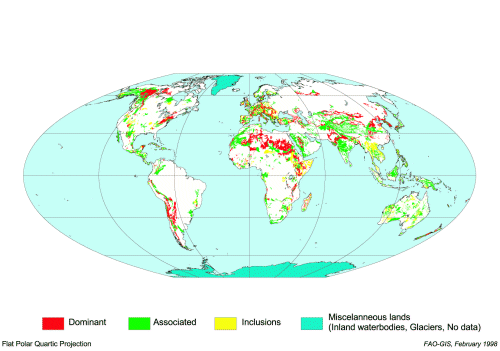
Cambisols
Encyclopedia

Fão
Fão is a town in Esposende Municipality in Portugal....
World Reference Base for Soil Resources
World Reference Base for Soil Resources
The World Reference Base for Soil Resources is the international standard taxonomic soil classification system endorsed by the International Union of Soil Sciences . It was developed by an international collaboration coordinated by the International Soil Reference and Information Centre and...
is a soil
Soil
Soil is a natural body consisting of layers of mineral constituents of variable thicknesses, which differ from the parent materials in their morphological, physical, chemical, and mineralogical characteristics...
with a beginning of soil formation. The horizon
Horizon
The horizon is the apparent line that separates earth from sky, the line that divides all visible directions into two categories: those that intersect the Earth's surface, and those that do not. At many locations, the true horizon is obscured by trees, buildings, mountains, etc., and the resulting...
differentiation is weak. This is evident from weak, mostly brownish discolouration and/or structure formation in the soil profile.
Cambisols are developed in medium and fine-textured materials derived from a wide range of rocks, mostly in alluvial, colluvial
Colluvium
Colluvium is the name for loose bodies of sediment that have been deposited or built up at the bottom of a low-grade slope or against a barrier on that slope, transported by gravity. The deposits that collect at the foot of a steep slope or cliff are also known by the same name. Colluvium often...
and aeolian deposits.
Most of these soils make good agricultural land and are intensively used. Cambisols in temperate climate
Climate
Climate encompasses the statistics of temperature, humidity, atmospheric pressure, wind, rainfall, atmospheric particle count and other meteorological elemental measurements in a given region over long periods...
s are among the most productive soils on earth.
Cambisols cover an estimated 15 million square kilometres worldwide. They are well represented in temperate and boreal regions that were under the influence of glaciation during the Pleistocene
Pleistocene
The Pleistocene is the epoch from 2,588,000 to 11,700 years BP that spans the world's recent period of repeated glaciations. The name pleistocene is derived from the Greek and ....
, partly because the soil's parent material
Material
Material is anything made of matter, constituted of one or more substances. Wood, cement, hydrogen, air and water are all examples of materials. Sometimes the term "material" is used more narrowly to refer to substances or components with certain physical properties that are used as inputs to...
is still young, but also because soil formation is comparatively slow in the cool, northern regions. Cambisols are less common in the tropics and subtropics. But they are common in areas with active erosion
Erosion
Erosion is when materials are removed from the surface and changed into something else. It only works by hydraulic actions and transport of solids in the natural environment, and leads to the deposition of these materials elsewhere...
where they may occur in association with mature tropical soils.

